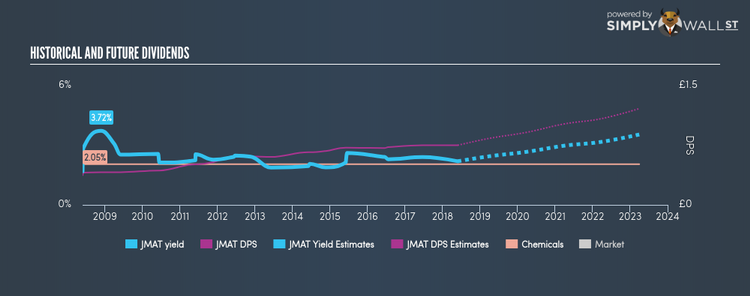Why Johnson Matthey Plc (LON:JMAT) Is A Dividend Rockstar

Over the past 10 years Johnson Matthey Plc (LSE:JMAT) has returned an average of 2.00% per year from dividend payouts. The stock currently pays out a dividend yield of 2.19%, and has a market cap of UK£6.56B. Does Johnson Matthey tick all the boxes of a great dividend stock? Below, I’ll take you through my analysis. Check out our latest analysis for Johnson Matthey
5 checks you should use to assess a dividend stock
When researching a dividend stock, I always follow the following screening criteria:
Is it paying an annual yield above 75% of dividend payers?
Has it paid dividend every year without dramatically reducing payout in the past?
Has dividend per share risen in the past couple of years?
Is it able to pay the current rate of dividends from its earnings?
Will it be able to continue to payout at the current rate in the future?
How does Johnson Matthey fare?
Johnson Matthey has a trailing twelve-month payout ratio of 38.81%, meaning the dividend is sufficiently covered by earnings. Going forward, analysts expect JMAT’s payout to remain around the same level at 37.65% of its earnings, which leads to a dividend yield of 2.65%. Furthermore, EPS is forecasted to fall to £1.93 in the upcoming year. Reliablity is an important factor for dividend stocks, particularly for income investors who want a strong track record of payment and a positive outlook for future payout. JMAT has increased its DPS from £0.37 to £0.75 in the past 10 years. It has also been paying out dividend consistently during this time, as you’d expect for a company increasing its dividend levels. These are all positive signs of a great, reliable dividend stock. In terms of its peers, Johnson Matthey produces a yield of 2.19%, which is high for Chemicals stocks but still below the market’s top dividend payers.
Next Steps:
Taking into account the dividend metrics, Johnson Matthey ticks most of the boxes as a strong dividend investment, putting it in my list of top dividend payers. Given that this is purely a dividend analysis, I recommend taking sufficient time to understand its core business and determine whether the company and its investment properties suit your overall goals. Below, I’ve compiled three essential factors you should further research:
Future Outlook: What are well-informed industry analysts predicting for JMAT’s future growth? Take a look at our free research report of analyst consensus for JMAT’s outlook.
Valuation: What is JMAT worth today? Even if the stock is a cash cow, it’s not worth an infinite price. The intrinsic value infographic in our free research report helps visualize whether JMAT is currently mispriced by the market.
Other Dividend Rockstars: Are there better dividend payers with stronger fundamentals out there? Check out our free list of these great stocks here.
To help readers see pass the short term volatility of the financial market, we aim to bring you a long-term focused research analysis purely driven by fundamental data. Note that our analysis does not factor in the latest price sensitive company announcements.
The author is an independent contributor and at the time of publication had no position in the stocks mentioned.

 Yahoo Finance
Yahoo Finance 
